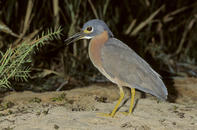
White-backed Night-Heron
Name
White-backed night heron (Gorsachius leuconotus)
White-backed Night Heron Appearance
The white-backed night heron has a black head with a large eye that is surrounded by a white eye-ring. The white-backed night heron has a rufous upper chest and neck.
The narrow white plumes on the back are concealed when the bird is perched. The bill is black and the legs are a greenish yellow to grey-green.
The white-backed night heron has a yellow to chestnut coloured eye. The sexes are similar. The total body length is around 53 cm.
White-backed Night-Heron Diet
The white-backed night heron feeds on crustaceans, frogs, insects and fish.
White-backed Night-Heron Breeding
The white-backed night heron builds a platform made from twigs and stalks in overhanging vegetation, near water. The female lays 2 or 3 eggs. The incubation is shared between the parents and takes around 25 days. The chicks are fed by both parents and fledge at around 7 weeks.
White-backed Night-Heron Behaviour
The white-backed night heron is mostly nocturnal but will feed crepuscular (during twilight). It is a very shy bird and is rarely seen. It roosts in trees along the waterways during the day. If disturbed, it will climb or run upwards in the vegetation before flying off.
White-backed Night-Heron Threats
In South Africa, the white-backed night heron is considered vulnerable. The main threat for this heron is habitat destruction.
White-backed Night-Heron Distribution and Habitat
The white-backed night heron is found along quite backwaters with overhanging vegetation. This heron is uncommon in South Africa and found in Limpopo and the eastern parts of Mpumalanga Provinces.
